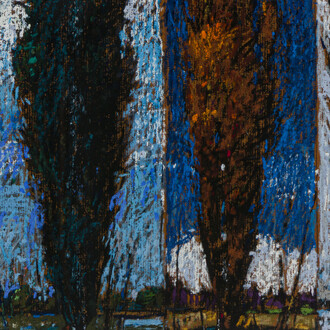Late Summer of the Castilian Year 1680: A firelight flickers in a crowded kiva as a group of people whisper, heads together. Po’pay has called on delegates from all the surviving Pueblos to convene in Taos for a secret meeting, and he tells them the time is ripe for the uprising. Castilian invaders have ravaged their homelands for decades, destroyed and stolen their crops, and decimated their population. If the Pueblos are to survive and keep their traditions alive, Po’Pay says, the time for action is now before they are extinguished and lost forever. But where to begin if they are to defend themselves against the murderous invaders and bring back the rain?
On August 10, the 344th anniversary of the Pueblo Revolt, Virgil Ortiz’s Daybreak of the resistance will open at Container in Oga Po’geh, or Santa Fe as it is known today. Here, Po’Pay and his Pueblo allies, together with the Recon Watchmen, Runners, Gliders, and the Blind Archers Army, converge to defeat the destructive Castilian forces once and for all. Ortiz and collaborative artists Morgan Barnard, Jonathan Sanchez, William T. Carson, Patrick Lachman, and Alex Sokol will present the Daybreak storyline in an immersive art experience featuring never-before-seen work in clay, sculptures, paintings, and SFX projection mapping. The Resistance is coming, and it arrives at Daybreak!
In the ever-evolving landscape of contemporary art, few figures shine as brightly as Virgil Ortiz. He is a luminary in the realm of clay whose groundbreaking contributions have not only redefined the boundaries of pottery, but also elevated the cultural narrative of the Pueblo people to a global stage. Ortiz hails from a distinguished lineage of Pueblo potters that includes his mother, Seferina Ortiz, and grandmother, Laurencita Herrera. Their artistic legacy courses through his veins, and guides him on a journey transcending traditional boundaries and captivating audiences worldwide.
Ortiz is a polymath, expanding his artistic vision beyond the confines of pottery. He skillfully weaves design, digital media, video, and film into his ever-expanding, boundless practice, creating a rich, multi-sensory experience that offers an insightful perspective into the Puebloan history and culture. From a young age, Ortiz's remarkable skills caught the attention of a Cochiti elder, who asked him to carry on the tradition of sharing the stories of the Pueblo Revolt with the younger generation. This was to ensure that the significant historical events and the unique artistic techniques, materials, and traditions of the Cochiti Pueblo are never forgotten. Ortiz is driven by this calling to honor and preserve the past, which is evident in his career and inspirational work. Through his art and activism, Ortiz is dedicated to keeping the tradition of the Cochiti Pueblo and the invaluable knowledge of his ancestors alive. He is one of the few individuals who continue to uphold the tradition of traditional pottery.
In each collaboration and creation, Virgil Ortiz skillfully crafts a dialogue between the past and the present, ensuring that the voices of his ancestors echo through the corridors of today. His works remind us that true innovation arises when tradition and modernity engage in a harmonious dance. His ability to seamlessly weave the threads of his heritage into the fabric of contemporary art positions him as a visionary whose work will undoubtedly leave an indelible mark on the artistic landscape for generations to come.
Ortiz’s works have been featured in numerous museum exhibitions around the world, including the National Museum of the American Indian in Washington, DC, ReVOlt 1680/2180: sirens and sikas, Autry Museum, Los Angeles, CA, To take shape and meaning, North Carolina Museum of Art, Raleigh, NC, Shadow and light, Museum of New Mexico Vladem Contemporary, Santa Fe, NM, Painted: our bodies, hearts, and village, Colby Museum of Art, Waterville, ME, Revolt 1680/2180: runners + gliders, History Colorado Center, Denver, CO, Siamo Foresta, Triannale Milano, Milan, Italy, Virgil Ortiz: secret passkeys and portals at The House of Eternal Return, Meow Wolf Santa Fe, NM, Stedelijk Museum-Hertogenbosch in The Netherlands. Ortiz also has future exhibitions opening soon at the Getty, the Autry, and the Lowe Museum.
Ortiz’s extensive exhibition history highlights his artistic vision and reflects his strong connection to his Cochiti Pueblo heritage. Ortiz's work vividly expresses the rich cultural heritage of the Pueblo people, passed down through generations, and invites viewers to delve into the intricate interplay between tradition and innovation.
















